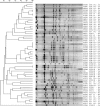Multilocus sequence typing of methicillin-resistant Staphylococcus aureus from an area of low endemicity by real-time PCR
- PMID: 16145090
- PMCID: PMC1234089
- DOI: 10.1128/JCM.43.9.4448-4454.2005
Multilocus sequence typing of methicillin-resistant Staphylococcus aureus from an area of low endemicity by real-time PCR
Abstract
A protocol for multilocus sequence typing (MLST) of methicillin-resistant Staphylococcus aureus (MRSA) was adapted to real-time LightCycler System PCR for efficient and rapid amplification of seven housekeeping genes in the same PCR run and real-time detection of the products. The method was evaluated on a representative and well-characterized collection of clinical MRSA isolates (n = 57) obtained from an area of low endemicity. Twenty sequence types (STs) and nine clonal complexes were identified. Combining STs and the staphylococcal cassette chromosome mec (SCCmec) type identified 27 different genotypes, and type IV SCCmec was present in 11 different STs. The presence of the Panton Valentine leukocidin (PVL) genes was found in isolates of four different STs. Eleven different STs were found among the community-acquired as well as among the hospital-acquired MRSA. The genetic heterogeneity was also denoted by pulsed-field gel electrophoresis analysis that showed 24 different pulsotypes among the 57 MRSA isolates. The presence of more than one different type of SCCmec in the same ST indicates that the MRSA clones have arisen at several occasions in the same genetic background by independent acquisition of SCCmec into methicillin-sensitive strains. This circumstance shows the importance of combining MLST data with SCCmec-typing results when investigating the origins of MRSA.
Figures
References
-
- Berglund, C., P. Mölling, L. Sjöberg, and B. Söderquist. 2005. Predominance of staphylococcal cassette chromosome mec (SCCmec) type IV among methicillin-resistant S. aureus (MRSA) in a Swedish County, and presence of unknown SCCmec types with Panton-Valentine leukocidin genes. Clin. Microbiol. Infect. 11:447-456. - PubMed
-
- Centers for Disease Control and Prevention. 1999. Four pediatric deaths from community-acquired methicillin-resistant Staphylococcus aureus-Minnesota and North Dakota, 1997-1999. JAMA 282:1123-1125. - PubMed
-
- Crisostomo, M. I., H. Westh, A. Tomasz, M. Chung, D. C. Oliveira, and H. de Lencastre. 2001. The evolution of methicillin resistance in Staphylococcus aureus: similarity of genetic backgrounds in historically early methicillin-susceptible and -resistant isolates and contemporary epidemic clones. Proc. Natl. Acad. Sci. USA 98:9865-9870. - PMC - PubMed
-
- Daum, R. S., T. Ito, K. Hiramatsu, F. Hussain, K. Mongkolrattanothai, M. Jamklang, and S. Boyle-Vavra. 2002. A novel methicillin-resistance cassette in community-acquired methicillin-resistant Staphylococcus aureus isolates of diverse genetic backgrounds. J. Infect. Dis. 186:1344-1347. - PubMed
Publication types
MeSH terms
Substances
LinkOut - more resources
Full Text Sources
Medical
Molecular Biology Databases


